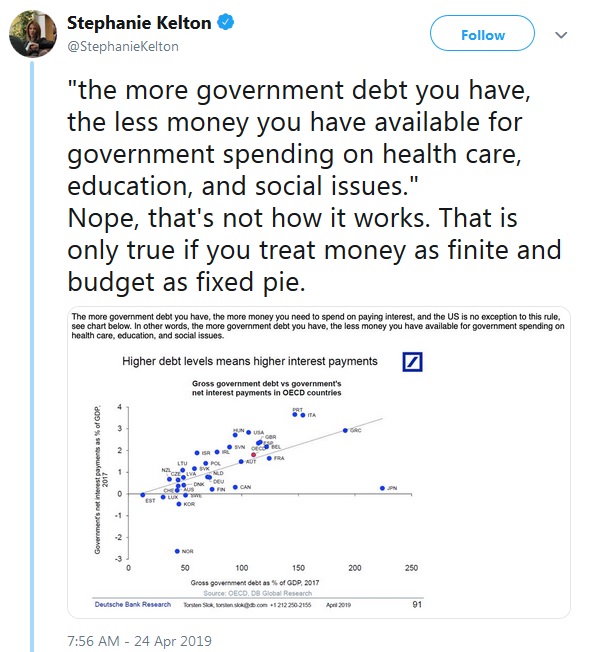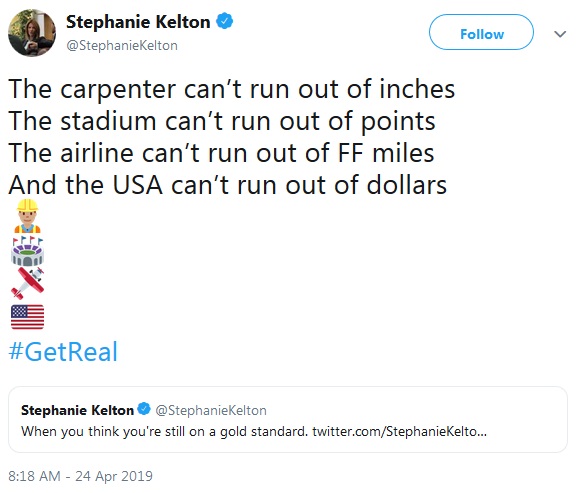Deutsche Bank put out an imprecise piece of research saying that higher debt levels mean higher government interest payments. This isn’t really true because the government can technically set its interest rates at whatever it wants. For instance, there was nothing stopping the Fed from keeping rates at 0% forever.¹ What DB was really implying was that there is a direct connection between debt and inflation (which interest rates are primarily a function of). But this is not really a good conclusion considering that there is ample evidence that higher government debt does not necessarily lead to high inflation (eg, see the USA or Japan over the last 30 years). So, we shouldn’t claim that government debt necessarily causes inflation or higher interest rates. Anyhow, Stephanie Kelton of MMT
Topics:
Cullen Roche considers the following as important: Most Recent Stories
This could be interesting, too:
Cullen Roche writes Understanding the Modern Monetary System – Updated!
Cullen Roche writes We’re Moving!
Cullen Roche writes Has Housing Bottomed?
Cullen Roche writes The Economics of a United States Divorce
Deutsche Bank put out an imprecise piece of research saying that higher debt levels mean higher government interest payments. This isn’t really true because the government can technically set its interest rates at whatever it wants. For instance, there was nothing stopping the Fed from keeping rates at 0% forever.¹ What DB was really implying was that there is a direct connection between debt and inflation (which interest rates are primarily a function of). But this is not really a good conclusion considering that there is ample evidence that higher government debt does not necessarily lead to high inflation (eg, see the USA or Japan over the last 30 years). So, we shouldn’t claim that government debt necessarily causes inflation or higher interest rates.
Anyhow, Stephanie Kelton of MMT fame one-upped DB’s bad conclusion with an even worse conclusion of her own. She said:

This is a central tenet of MMT – the idea that money isn’t a scarce resource. To emphasize this point and understand how fundamentally wrong it is, it’s helpful to look at Kelton’s next Tweet:

Let’s look at one of these examples more closely. For instance, here’s a stadium that has functionally run out of points:

I know, I know. The stadium hasn’t really run out of points. As long as there are people there willing to put numbers on the board it still has points. But if you put numbers up on the board and no one’s playing the game does it really matter whether you claim to still have points? No, it doesn’t.
And this is where MMT kind of falls apart with what I would say is a rather basic misunderstanding of the concept of “funding” in finance. When high inflation is raging through a country the government can still technically put points on the board by printing money, but the reason your currency is hyperinflating is, in part, because people aren’t playing the economic game with your points any more. In other words, government currencies hyperinflate when the demand for that currency collapses relative to real goods and services. This is like the stadium that can still technically put points on the board, but is no longer tracking a game that people care to watch. Just as the demand for seeing the stadium’s points has collapsed so too does the demand for seeing government money when inflation is high.
The key point is, money is in fact a scarce resource. The fact that we can print money and create money endogenously does not mean that it can be created infinitely or that the government doesn’t rely on demand for its money.²
¹ – There is considerable debate and evidence that this is not a good idea in the case of rising inflation, but that’s not my point. My point is that even if inflation were spiralling out of control the government could still keep rates at 0%. Whether this would make inflation even worse is a different matter.
² – This is related to the MMT concept that government spending is “self financing”. This is no more true than the (very wrong) notion that a corporation issuing equity is “self financing” just because it issues a money-like instrument that it alone creates from thin air.
